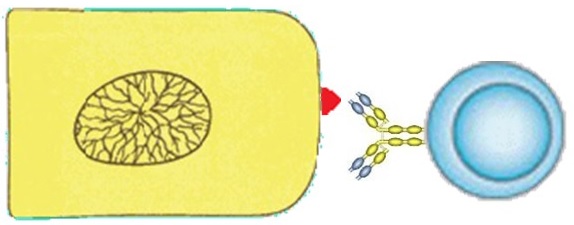|
|

ADAPTIVE IMMUNE RESPONSES
B-cell Effector Activity
SPECIFIC ANTIBODIES, effector molecules of the B-cell-mediated responses, have several modes of action, which engage cells and molecules of the innate immunity. The antibodies are directed against extracellular microbes.
There are two effector mechanisms of B-cell effector activity: (1) pathogen neutralization by specific antibodies with the formation of immune complexes; and (2) Antibody-Dependent Cellular Cytotoxicity (ADCC).
(1)
The most frequent effector mechanism is neutralization in which specific antibodies bind antigens and can block parts of the surface of pathogens to inactivate them. During this process, the formation of immune complexes involves an antibody, an antigen, and, in some types of immune complexes, complement. If the immune complexes comprise IgG and IgA of high affinity for an antigen, the inactivation of a pathogen will be effective.may be large, medium-sized and small. Large immune complexes contain many molecules of antibodies and complement, i.e. they are formed in excess of antibodies; hence they may be carried by erythrocytes, which express CR1, in the liver and spleen and then be well-phagocyted. They are physiological. The small immune complexes constituted in the slight excess of antigen also comprise complement and can be carried by erythrocytes and phagocyted too. However, they can be deposited in the tissues. The medium-sized immune complexes, formed in excess of antigen, lattice-like and C3b-free, are insoluble and cannot be lightly removed. Therefore, they are known as pathogenic.
The immune complexes
Lysis of the pathogens occurs if, during the binding of an antibody to the antigen, immune complexes fix complement, which is activated via a classical pathway. Antibodies may be opsonins, sticking to pathogens, which results in phagocytosis of the pathogens. The formation of immune complexes, activation of complement, opsonization and phagocytosis finally lead to the development of immune inflammation.
(2) In Antibody-Dependent Cellular Cytotoxicity (ADCC), FcγRs on the surface of innate effector cells (NK cells, macrophages and eosinophils) bind to the Fc fragment of a specific antibody, IgG, which itself is bound to a target cell. ADCC's effector function is potent for human IgG1 and IgG3 and weak for IgG2 and IgG4. According to signaling, a variety of substances such as lytic enzymes, perforin, granzymes, and TNF are released and mediate the destruction of the target cell.
This mechanism is available in graft rejection and defense against helminth and protozoan parasites.

©V.V.Klimov